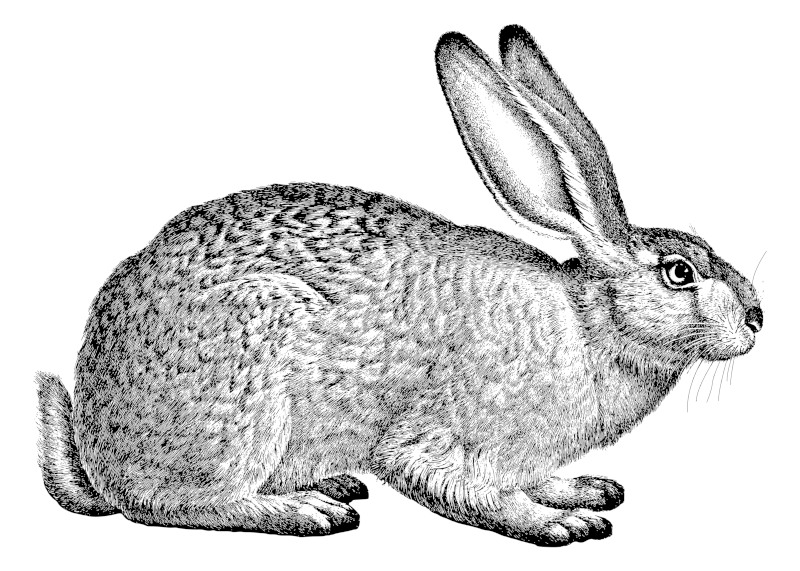Here we examine some easy animal drawings to study and find inspiration from, as well as some more complex animal drawings from a variety of different artists, dating back several centuries.
Introduction to Animal Drawings
Animals have been popular choices within art for many centuries, and even the most occasional art follower will normally find interest in perhaps a drawing of a butterfly, or a horse painting. Within this article we examine different aspects of animal art, and present some of the artists most famous for this unique but challenging genre. There is a full list of paintings, woodcuts and pencil illustrations, giving a wide variety of options and ideas.
Animal art has evolved over the years, going from highly scientific, precise studies from the 18th and 19th century, all the way through to more abstract forms in the modern day. A lot can be achieved with just a few lines, when the artist is prepared, and today we often see an interest in the more minimal animal sketches which tend to suit the style of modern homes.
List of Animal Drawings and Paintings
Our list below includes details on each image, as well as the artist behind it, where that is available. All images are from public domain sources, including rawpixels, and are intended for educational purposes for those looking to learn the tips and techniques of drawing and painting many different animals. This site also includes other topics such as various insects and standard portraits.
You might practice tracing some of these items, or reducing them down to a relatively small number of lines and detail in order to understand how to drew basic examples of each animal. For those more confident, you can then start to add more visual detail, and perhaps start to experiment with colors too. Some might make use of digital art techniques, where errors can be altered easily, such as by drawing on a tablet device.
Sitting Cat by Julie de Graag
Julie de Graag was a delightful Art Nouveau artist who worked in a minimalist manner and covered a large number of animals and insects across her career. All are styled in a similar format to the work seen below, which captures a sitting cat, face-on. We are all familiar with cats in this posture, but perhaps have rarely seen it depicted in this style, where negative space is removed from the black, to create a cat form, in an ingenious manner. Aside from the black lines around the outside, a pattern of orange and cream completes the cat's pattern.
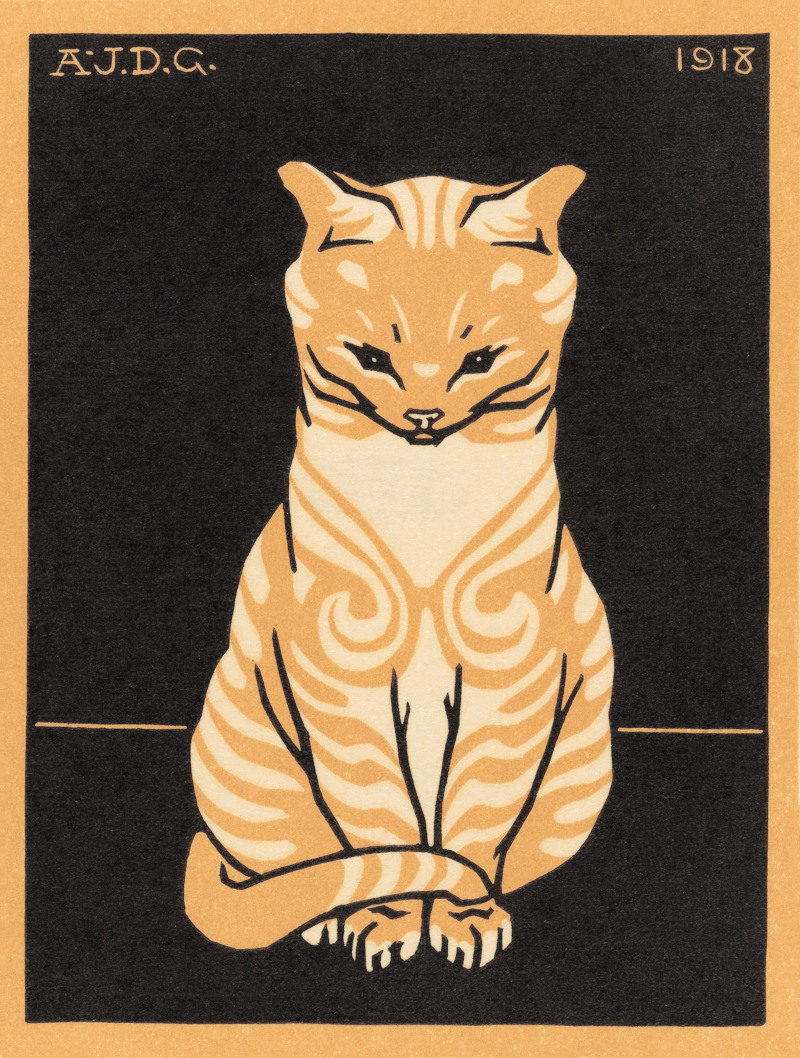 Sitting Cat by Julie de Graag (Public Domain image, courtesy of Rawpixel)
Sitting Cat by Julie de Graag (Public Domain image, courtesy of Rawpixel)
Dog's Head by Julie de Graag
In this work de Graag forms the head of a dog with patterns of small strokes, which together create the overall composition. There is an impressive consistency in the width and direction of the lines themselves, and they tend to follow the direction of the dog's fur, meeting just above the animal's eyes and nose. This type of approach is presented in black and white, but could easily be altered digitally, with the white replaced by any color that you might like. The piece is dated 1920, despite its highly contemporary feel.
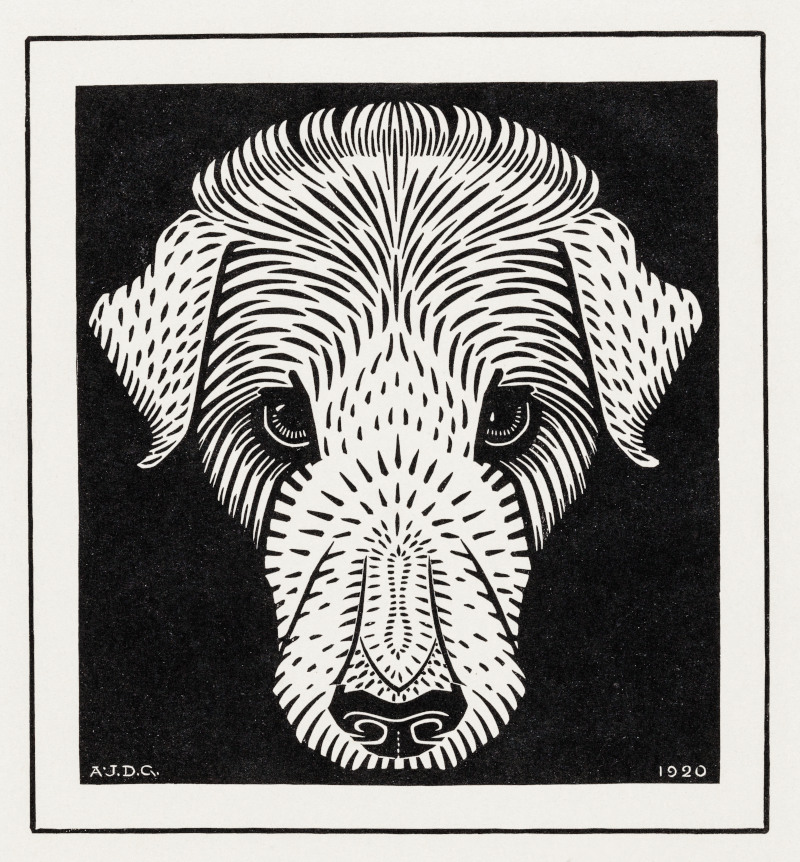 Dog's Head by Julie de Graag (Public Domain image, courtesy of Rawpixel)
Dog's Head by Julie de Graag (Public Domain image, courtesy of Rawpixel)
Two Rabbits by Julie de Graag
Another stunning drawing by de Graag is this side profile of two rabbits in black and white - the genius of this artwork is in how much is achieved with so little detail. Much of what we see is actually suggested by our existing knowledge of rabbit anatomy, meaning the artist does not have to include too much. The relaxed posture of these duplicate rabbits makes for a highly charming artwork, and perhaps one of this artist's most famous animal drawings.
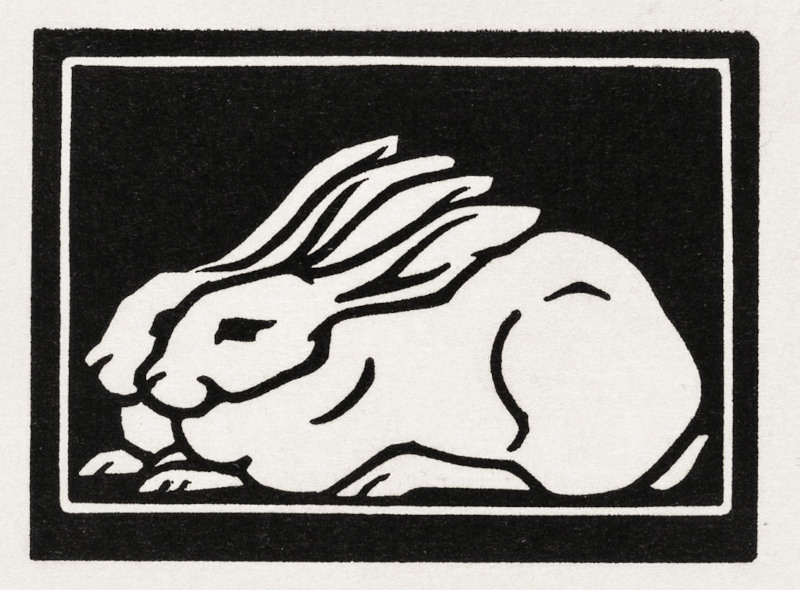 Two Rabbits by Julie de Graag (Public Domain image, courtesy of Rawpixel)
Two Rabbits by Julie de Graag (Public Domain image, courtesy of Rawpixel)
Highly Detailed Rabbit or Hare Drawing
This sketch of a hare is incredible for the level of detail used. The artist, no doubt, would have spent considerable time observing this creature prior to putting this sketch together, and likely would have continued to refer to images of it as the design was developed. The way in which the fur varies in thickness is extraordinary, though for those looking to learn how to draw a rabbit, this work might be a little too complicated to start off with first, with something more simple being a better idea, first up.
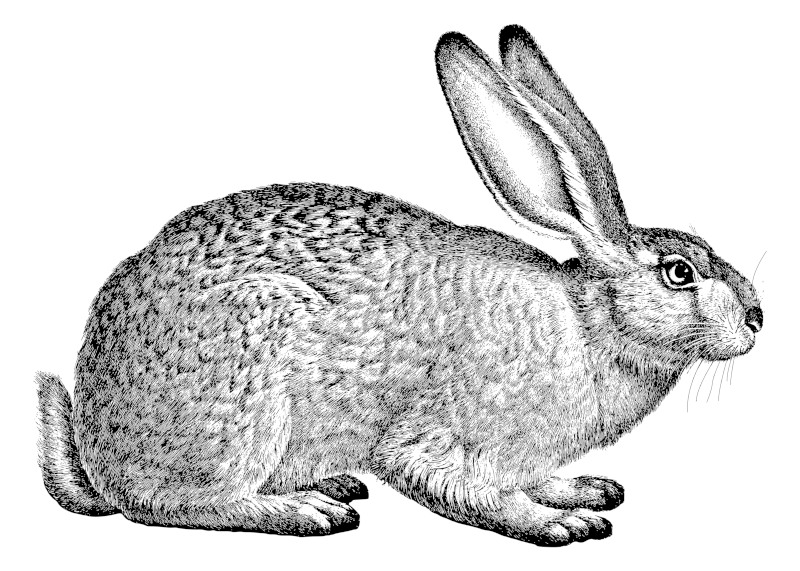 Highly Detailed Rabbit or Hare Drawing (Public Domain image, courtesy of Rawpixel)
Highly Detailed Rabbit or Hare Drawing (Public Domain image, courtesy of Rawpixel)
Wolf Line Illustration
Here we find a drawing of a wolf in side profile. It looks directly at us, helping us to develop a connection to the creature. Normally, most artists using the side profile will have animals looking off across to the side, which was an idea found commonly within scientific art. The wolf looks relaxed in its posture, with its tongue hanging out, as it wanders past. A simple use of line allows us to understand the direction of its fur, and the balance of muscle.
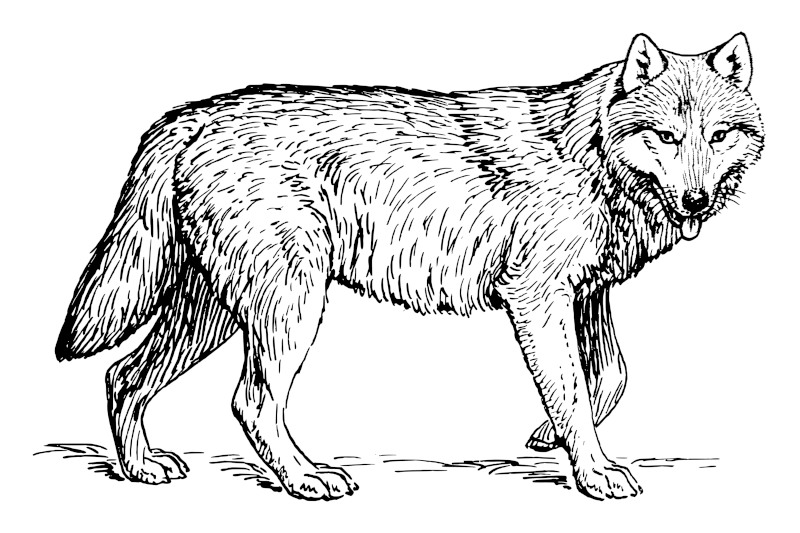 Wolf Line Illustration (Public Domain image, courtesy of Rawpixel)
Wolf Line Illustration (Public Domain image, courtesy of Rawpixel)
Horses Japanese Animal Ink Illustration
Japanese artists are famed for their animal art, and here we find the use of black ink which delivers two horses in a playful scenario. Their manes are constructed from a repetition of curved lines, with their heads bowed towards the floor. The lower halfs of their legs are entirely in black ink, whilst upper sections and main bodies are left blank, taking in the white tone of the original paper, through the use of negative space. Despite being centuries old, this image actually feels somewhat contemporary in appearance.
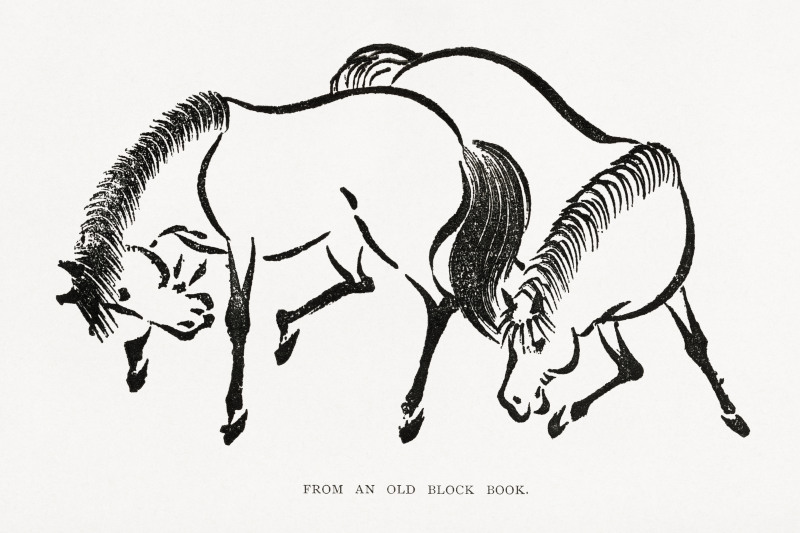 Horses Japanese Animal Ink Illustration (Public Domain image, courtesy of Rawpixel)
Horses Japanese Animal Ink Illustration (Public Domain image, courtesy of Rawpixel)
Giraffe Illustration by Pierre Jean Francois Turpin
Pierre Jean Francois Turpin was one of a number of highly skilled French artists who could achieve incredible detail with their depictions of animals, insects and plants. The accuracy was so impressive, that it was almost as useful as photography and could serve educational purposes for those unable to see some of these creatures in person. The patterned section of the giraffe is particularly impressive in this piece, and many at this time in Europe would have found this creature to be highly exotic.
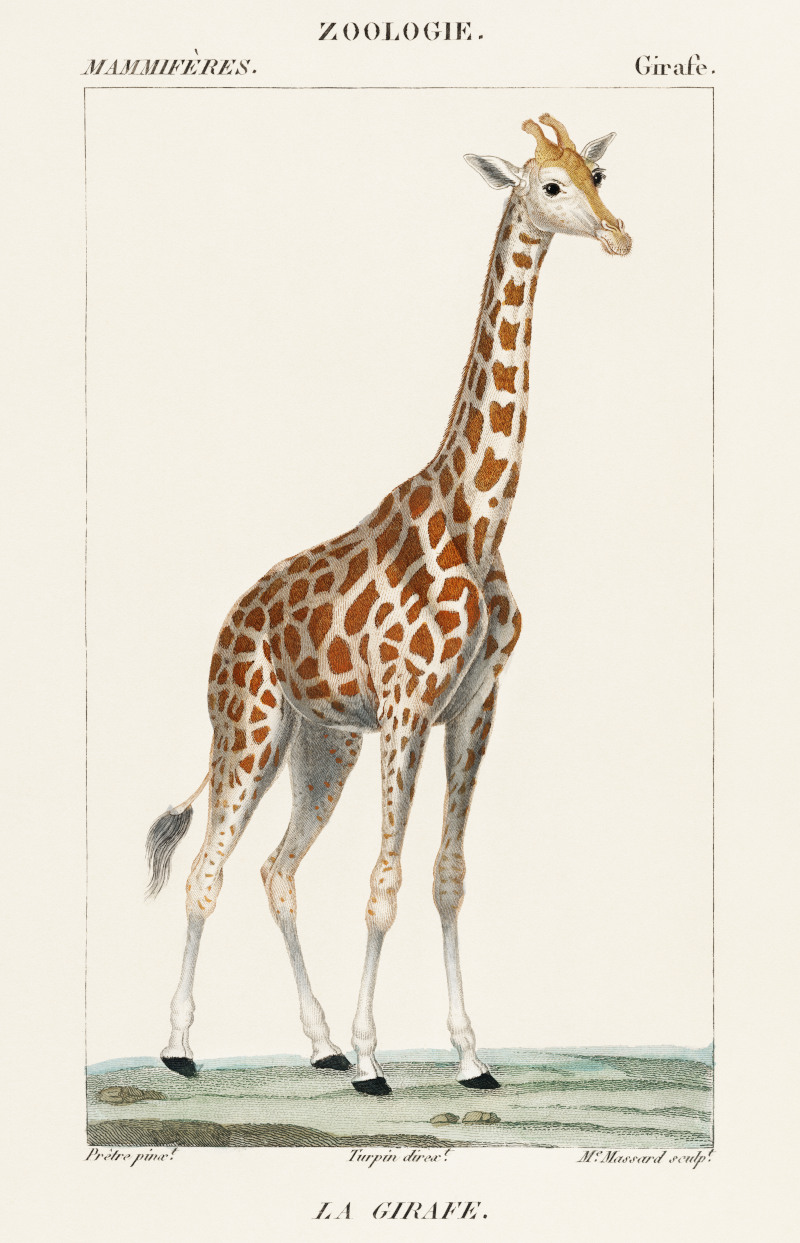 Giraffe Illustration by Pierre Jean Francois Turpin (Public Domain image, courtesy of Rawpixel)
Giraffe Illustration by Pierre Jean Francois Turpin (Public Domain image, courtesy of Rawpixel)
Hippopotamus illustrated by Charles Dessalines D' Orbigny
Charles Dessalines D'Orbigny sketches this Hippopotamus to a high degree of accuracy within this artwork. It would have been incorporated into an extensive publication, with many other animals used alongside, and normally there was a theme to summarise them all, such as animals from a particular location or species.
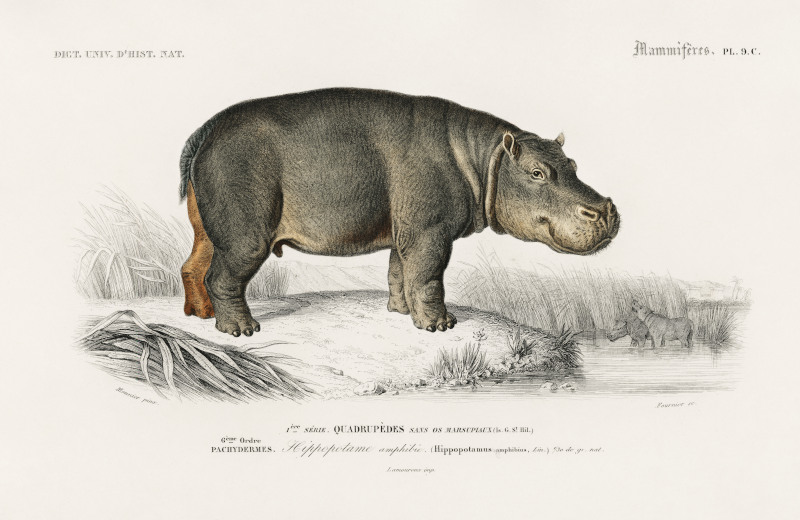 Hippopotamus illustrated by Charles Dessalines D' Orbigny (Public Domain image, courtesy of Rawpixel)
Hippopotamus illustrated by Charles Dessalines D' Orbigny (Public Domain image, courtesy of Rawpixel)
Vintage Cow Drawing
This detailed cow drawing reveals much about the muscular make-up of this creature, as we examine the contours of its body. A light background is placed behind the cow in order to create an outdoor setting, though most of the work completed here is around the anatomy of the animal itself. This vintage sketch is completed from side profile, which is the best angle for delivering as much visual information about this breed as possible, and was often how scientific studies would angle each animal in their own illustrations.
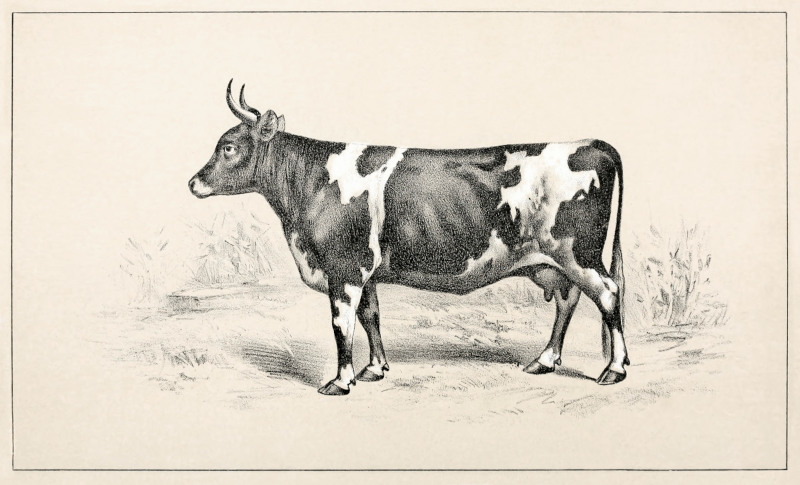 Vintage Cow Drawing (Public Domain image, courtesy of Rawpixel)
Vintage Cow Drawing (Public Domain image, courtesy of Rawpixel)
A Tiger, Full-Length, in Profile, Walking Towards Right by Thomas Stothard
This full length tiger profile was completed by Thomas Stothard in the 18th or 19th century. He was himself a highly skilled painter educated at the Royal Academy of Arts and we can see examples of that training throughout his bold and confident oeuvre. He would have initially been trained as a draughtsman, with tasks to portray all manner of creatures in order to develop a number of critical artistic techniques, including the observation of light and anatomy.
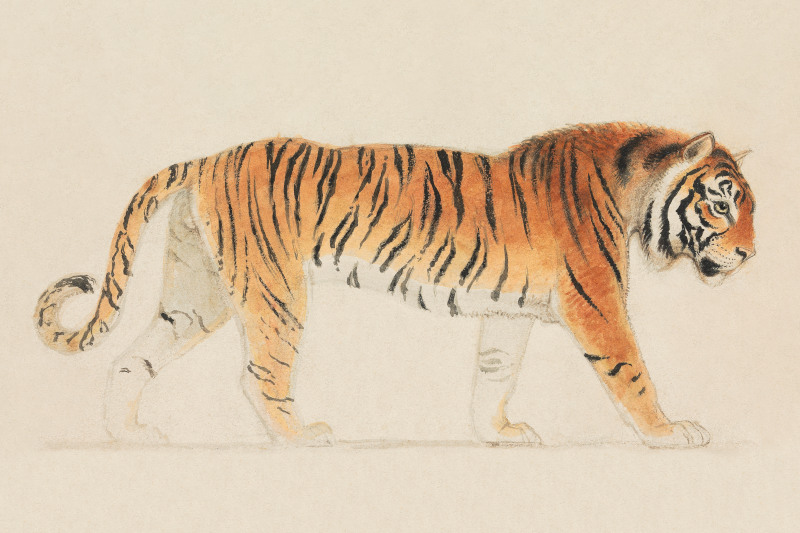 A Tiger, Full-Length, in Profile, Walking Towards Right by Thomas Stothard (Public Domain image, courtesy of Rawpixel)
A Tiger, Full-Length, in Profile, Walking Towards Right by Thomas Stothard (Public Domain image, courtesy of Rawpixel)
Holstein Cow Line Drawing
This delightful cow looks across to our right in a positive, confident manner. The key features of the animal are all included here, but the artist does not feel the need to go into too much detail. The leg and shoulder muscles can be identified by the use of line, and there is also just a little use of grass underneath the cow in order to add some context and perspective to the scene, anchoring the cow to the ground. One could use this as a basis for a simple sketch, working in an even more minimal fashion than found in this example.
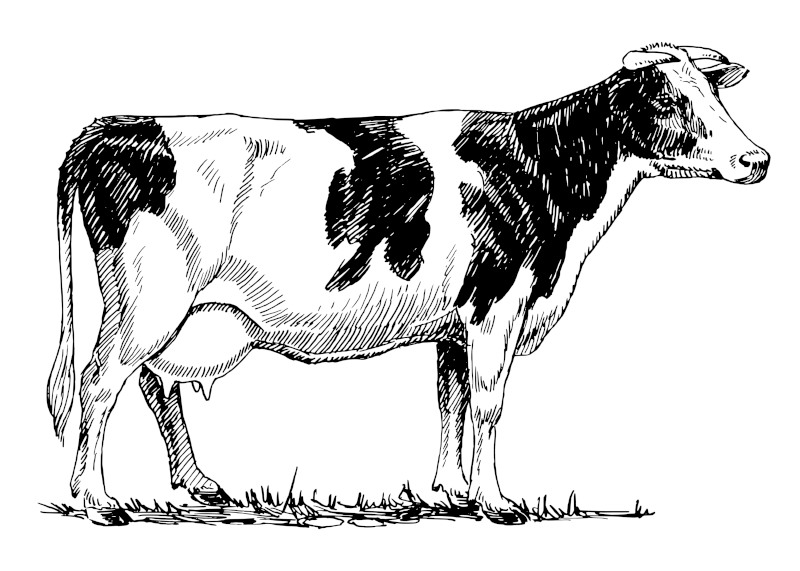 Holstein Cow Line Drawing (Public Domain image, courtesy of Rawpixel)
Holstein Cow Line Drawing (Public Domain image, courtesy of Rawpixel)
Vintage Pig Drawing
This vintage drawing of a pig captures one of the more famous breeds of this popular animals. It appears to be sniffing around for food, and is drawn from a side profile. The artist uses an intensive display of lines, closely placed together which helps us to understand the contours of its body. Many other pig drawings are far similar, and just focus on the basic outline of the animal which is a good way of starting off for those relatively unfamiliar with drawing.
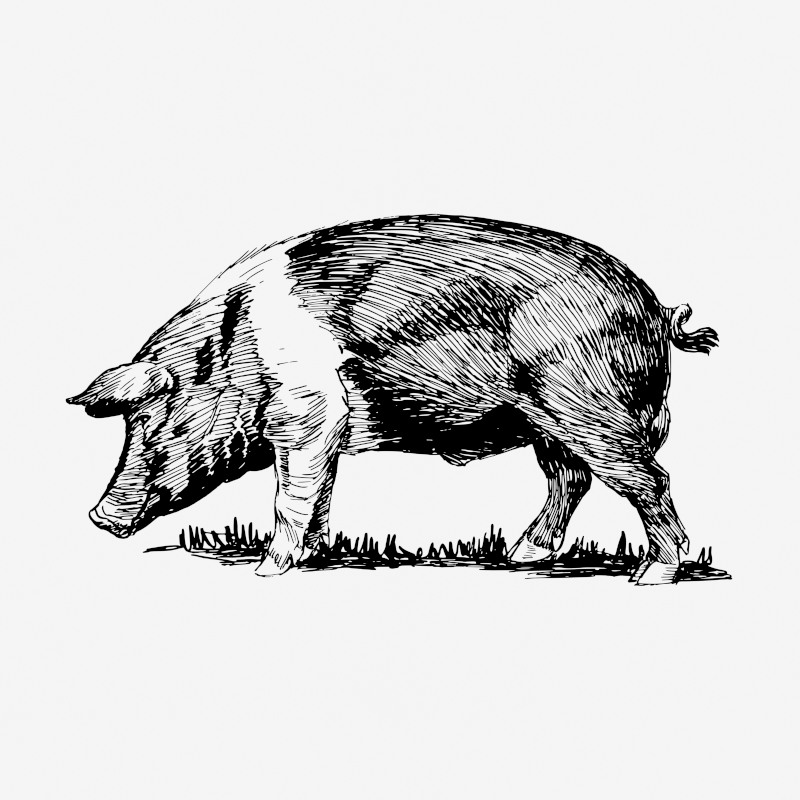 Vintage Pig Drawing (Public Domain image, courtesy of Rawpixel)
Vintage Pig Drawing (Public Domain image, courtesy of Rawpixel)
Collie Dog Illustration
This simple image, acquired from Rawpixel, displays a collie dog in a simple illustration that captures two brown tones which help us to identify the dog species. This style of drawing is similar to commercial illustration, where just the main features are included in order to provide a modern look, with large fragments of color that can be used effectively as posters. Dog drawings remain very popular, partly because of the number of dogs that are owned as pets across the world.
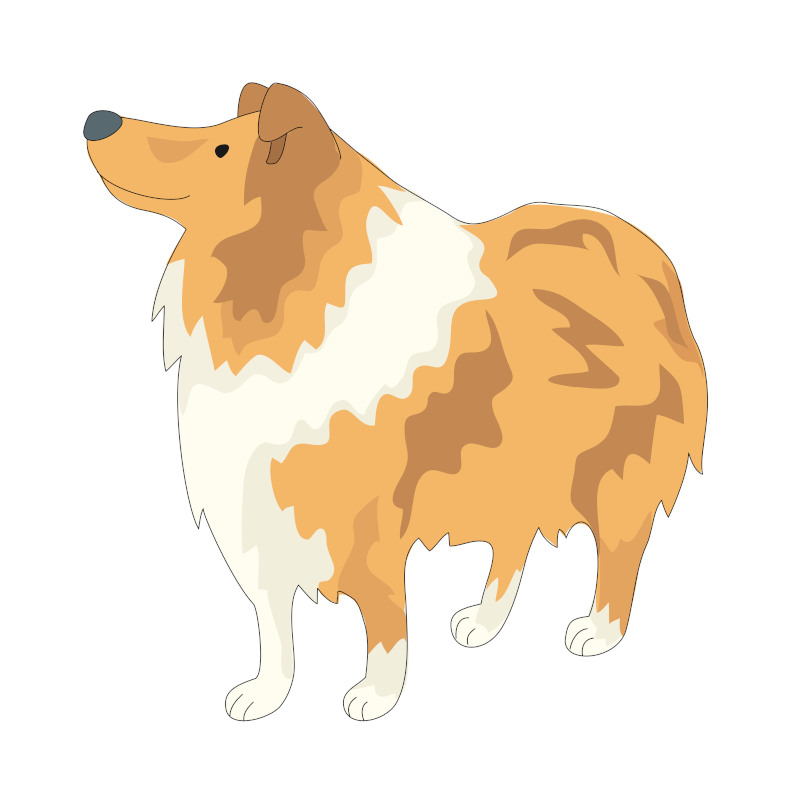 Collie Dog Illustration (Public Domain image, courtesy of Rawpixel)
Collie Dog Illustration (Public Domain image, courtesy of Rawpixel)
Guinea Pig Line Drawing
This simple sketch can teach you how to draw the outline of a guina pig, which is achieved relatively easily, but also accurately depicts this charming creature. Small shading is added beneath the ear, and around the lower half, just where it meets the surface on which the animal is perched. Many children love to have guinea pigs as pets, and so may be interested in drawing this creature themselves, perhaps by tracing this particular image and then potentially filling it in with their own colors.
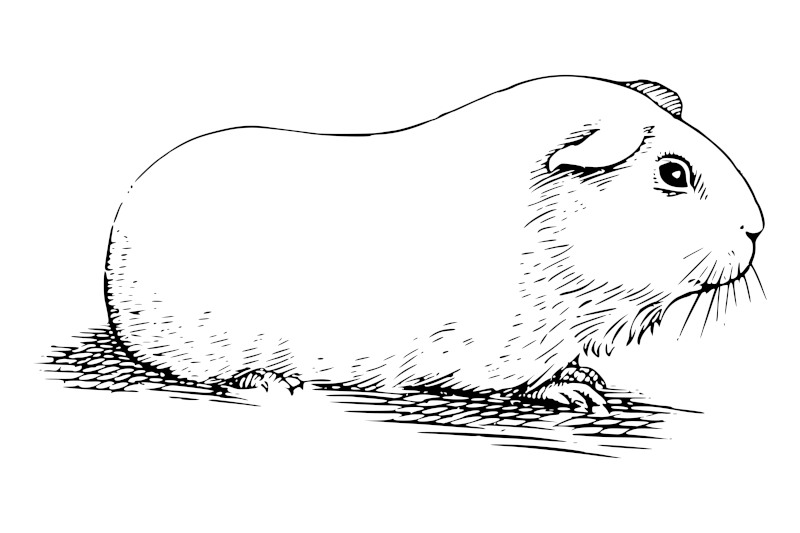 Guinea Pig Line Drawing (Public Domain image, courtesy of Rawpixel)
Guinea Pig Line Drawing (Public Domain image, courtesy of Rawpixel)
Simple, Easy Cat Sketch
This quick sketch creates much out of relatively few strokes of the pencil. The illustration delivers many aspects of the face of a cat, with which we are all familiar. The wide eyes stand out most of all, with prominent ears pointing with small hairs on top of their curved edges. Whiskers are loosely drawn, whilst the familiar patterns of this creature are added besides its eyes and between the ears.
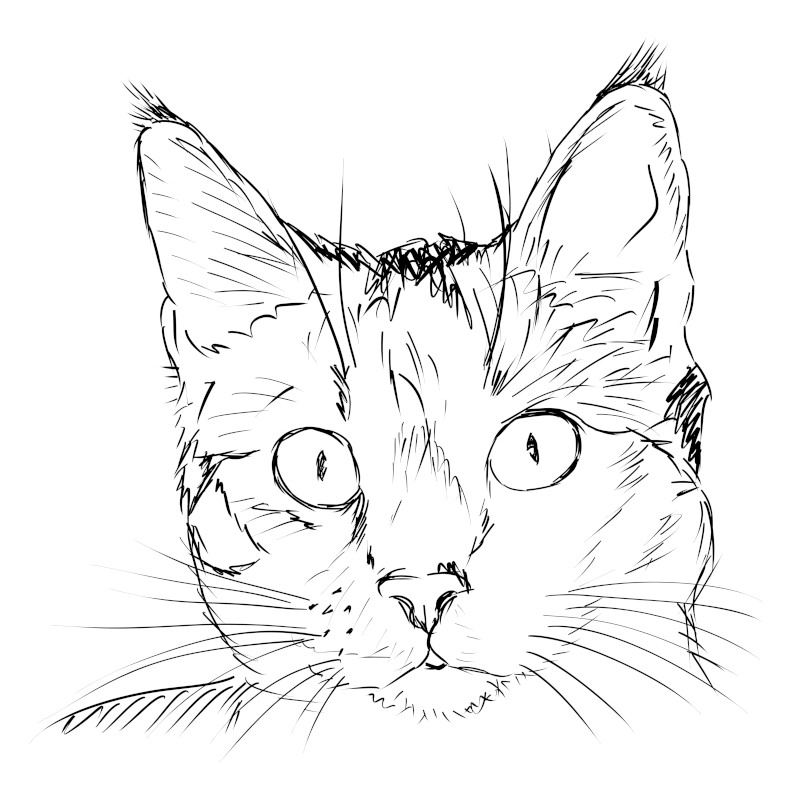 Simple, Easy Cat Sketch (Public Domain image, courtesy of Rawpixel)
Simple, Easy Cat Sketch (Public Domain image, courtesy of Rawpixel)
Sketch of a Cat by Jean Bernard
This is a highly realistic sketch from artist Jean Barnard. He likely would have observed many cats prior to completing this piece, and potentially worked on simpler iterations prior to this more detailed work. The depiction is so realistic, one can imagine reaching out to stroke the cat, as if it was our own pet. It looks across to the side, with a relaxed focus on something in the distance. The sketch includes touches of red on the cat's nose, but otherwise is just a series of tones of black, white and grey, along with the use of negative space which shows through the original colors of the paper beneath.
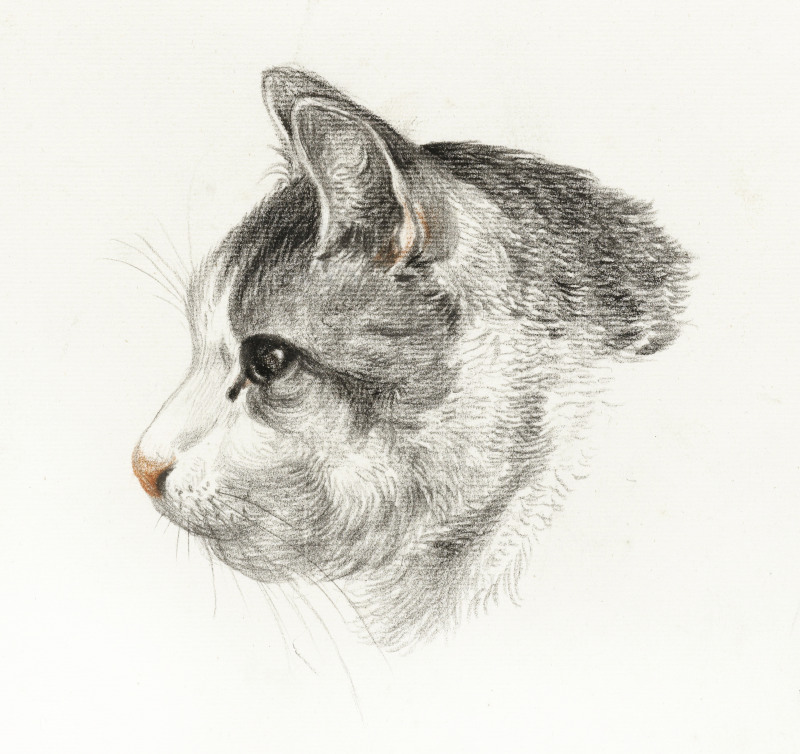 Sketch of a Cat by Jean Bernard (Public Domain image, courtesy of Rawpixel)
Sketch of a Cat by Jean Bernard (Public Domain image, courtesy of Rawpixel)
Beyond the Pencil: Innovative Mediums and Techniques
Scratchboards can be used by artists to create unusual depictions of animals. They will etch intricate details using knives and other sharp instruments in order to slowly build up an image. Ink and wash can be used in a manner which sits somewhere between drawing and watercolor painting, where fluid movements can generate very different atmospheres within each artwork, and were popular in Japanese art. There is also linocut and woodblock techniques.
Digital art has allowed artists to produce illustrations slowly, building up an image at their own leisure, and even sharing it with others online, who can make amendments themselves. Finally, the methods of studying animals can also vary, as one might observe a creature in its natural habitat, within a zoo setting, or even observe stuffed animals which was popular several centuries ago. Much will depend on the type of animal being covered.
Narratives in Lines: Storytelling through Animal Drawings
Animals are seen as charming by much of the population and for this reason are often used in various stories, typically aimed at children. Art can be used to get across the story, and to help embellish its messages by providing additional visual cues, with imagery normally laid alongside text as the story slowly unfolds. This has presented artists with a new challenge, of creating realistic animals which can also adapt to the story itself.
Fantasy also comes into many children's stories and that will involve a re-imagining of many creatures, who suddently can have a multitude of skills that they do not have in real life. Cartoons and animated films take this to the next level, where text is removed completely and the story is told through the audio, again challenging the artist to combine elements of reality with fantasy in a believable way.
Ethical Considerations in Animal Art
There are a number of ethical considerations when it comes to animal art. It is important to avoid impacting nature yourself through your methods of work, and there may even be safety issues to consider on both sides, depending on what you are drawing or painting. Photography can scare animals, when using bright lights, for example, or other sensitive parts of a natural habitat can be disturbed through your presence.
The Fascination of Animal Art
One of the unique qualities of nature is in its infinite amount of variety, giving endless inspiration to artists around the world. There is also a calming impact from many natural themes, which makes them popular with the public. Color combinations can excite any artist, and the addition of different lighting conditions brings plenty of elements to consideration. Another advantage is that animals can be accessible, with little knowledge required for the viewer to enjoy a piece, which brings a wider audience to each piece.
Many of us are interested in learning more about the natural world, and art can visually educate us within seconds. The habitat can be included within these artworks, allowing us to visualise how each animal would live within real life, when normally we might only witness them in books, or within the artificial setting of a zoo. Such art can be a great way of connecting with animals that we do not normally see, and also to consider their health and future, when some might be under threat without considerable conservation efforts from ourselves.
Connecting with Nature through Animal Art
There are many ways in which animal art can help us to connect directly with nature. By focusing on their natural habitats, we will also consider other creatures with which they interact, and also ponder about their own safety. Perhaps our own behavior might impact on them negatively, and so animal art can help us to reflect on our own future decisions. Where conservation is an issue, posters can be used with appropriate imagery to draw our attention to specific issues, and make a strong impact on us through clever visual design.
As we engulf ourselves in urban life as well as modern technology, it can be easy to completely disconnect from nature, but some impressive animal art in our homes, on our walls, or in our books can help to remind us of the alternative world out there. Reflecting on nature can also help to boost our own minds, which is why trups to the countryside are so invaluable to so many of us. Art can also help to record species which are close to extinction, so that later generations will have visual indicators of how they used to look - it must be remembered that the vast number of species that have existed at one point or another, no-longer do.
The Popularity of Animal Art for Wall Art Prints
Wall prints are popular ways to decorate one's home or office environment, and can be purchased at relatively cheap prices, when the print is not an original work. Animals are amongst the most popular theme for these prints, and deliver accessible art which anyone can enjoy, whether they have an understanding of art history, or not. Some will choose famous artists who have tackled this genre, such as Franz Marc or Wassily Kandinsky, whilst others will simply choose a print based on its qualities as they see it at the time.
Some with smaller budgets can acquire public domain animal drawings and print them out at home, before finding a cheaper frame to hang it in. This can be done by almost anyone, and also allows us to choose precisely the art that we want within our own home. Cheap prices mean we could also have more options, and rotate art between rooms from time to time. Animal prints remain amongst the most popular art print genre of all.
The wealth of animal art also makes it suitable for practically any taste, with many art movements have taken on this genre at some point, from Art Nouveau to the Renaissance, plus Expressionism to the Baroque - there really is something for everyone within the animal art genre.



